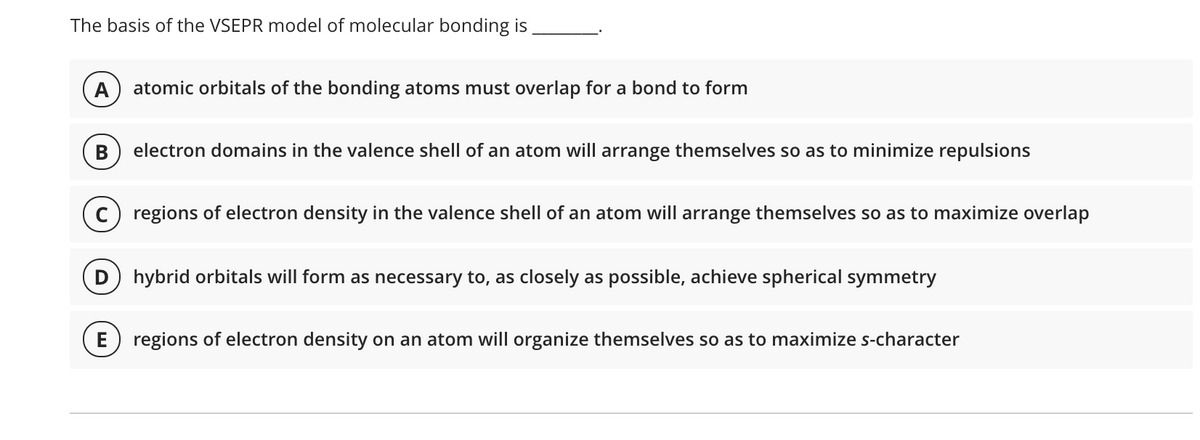A atomic orbitals of the bonding atoms must overlap for a bond to form electron domains in the valence shell of an atom will arrange themselves so as to minimize repulsions c) regions of electron density in the valence shell of an atom will arrange themselves so as to maximize overlap D hybrid orbitals will form as necessary to, as closely as possible, achieve spherical symmetry E) regions of electron density on an atom will organize themselves so as to maximize s-character
A atomic orbitals of the bonding atoms must overlap for a bond to form electron domains in the valence shell of an atom will arrange themselves so as to minimize repulsions c) regions of electron density in the valence shell of an atom will arrange themselves so as to maximize overlap D hybrid orbitals will form as necessary to, as closely as possible, achieve spherical symmetry E) regions of electron density on an atom will organize themselves so as to maximize s-character
Principles of Modern Chemistry
8th Edition
ISBN:9781305079113
Author:David W. Oxtoby, H. Pat Gillis, Laurie J. Butler
Publisher:David W. Oxtoby, H. Pat Gillis, Laurie J. Butler
Chapter6: Quantum Mechanics And Molecular Structure
Section: Chapter Questions
Problem 17P
Related questions
Question

Transcribed Image Text:The basis of the VSEPR model of molecular bonding is
A
atomic orbitals of the bonding atoms must overlap for a bond to form
B
electron domains in the valence shell of an atom will arrange themselves so as to minimize repulsions
regions of electron density in the valence shell of an atom will arrange themselves so as to maximize overlap
hybrid orbitals will form as necessary to, as closely as possible, achieve spherical symmetry
E
regions of electron density on an atom will organize themselves so as to maximize s-character
Expert Solution
This question has been solved!
Explore an expertly crafted, step-by-step solution for a thorough understanding of key concepts.
Step by step
Solved in 2 steps

Knowledge Booster
Learn more about
Need a deep-dive on the concept behind this application? Look no further. Learn more about this topic, chemistry and related others by exploring similar questions and additional content below.Recommended textbooks for you

Principles of Modern Chemistry
Chemistry
ISBN:
9781305079113
Author:
David W. Oxtoby, H. Pat Gillis, Laurie J. Butler
Publisher:
Cengage Learning

Chemistry: Principles and Practice
Chemistry
ISBN:
9780534420123
Author:
Daniel L. Reger, Scott R. Goode, David W. Ball, Edward Mercer
Publisher:
Cengage Learning

Organic Chemistry: A Guided Inquiry
Chemistry
ISBN:
9780618974122
Author:
Andrei Straumanis
Publisher:
Cengage Learning

Principles of Modern Chemistry
Chemistry
ISBN:
9781305079113
Author:
David W. Oxtoby, H. Pat Gillis, Laurie J. Butler
Publisher:
Cengage Learning

Chemistry: Principles and Practice
Chemistry
ISBN:
9780534420123
Author:
Daniel L. Reger, Scott R. Goode, David W. Ball, Edward Mercer
Publisher:
Cengage Learning

Organic Chemistry: A Guided Inquiry
Chemistry
ISBN:
9780618974122
Author:
Andrei Straumanis
Publisher:
Cengage Learning

Chemistry: The Molecular Science
Chemistry
ISBN:
9781285199047
Author:
John W. Moore, Conrad L. Stanitski
Publisher:
Cengage Learning

Chemistry for Engineering Students
Chemistry
ISBN:
9781337398909
Author:
Lawrence S. Brown, Tom Holme
Publisher:
Cengage Learning

Chemistry: Principles and Reactions
Chemistry
ISBN:
9781305079373
Author:
William L. Masterton, Cecile N. Hurley
Publisher:
Cengage Learning